Any guitar player encounters the choice of the best volume pedal during his or her practice. However, both a beginner and a seasoned player can get lost in the modern market variety for this gear. Despite being given a single purpose, these devices may be of many kinds, with or without numerous features, and vary in design and performance.
Let’s list the main parameters to check in the volume adjustment pedal for guitar:
- Transparent output. This type of pedal is valued the most when it doesn’t affect sound consistency. Some of the passive pedals tend to cut the high-frequency sound, which is also known as the “tone loss”. Still, it’s rather an individually estimated parameter.
- Solid build. The pedal is to be pressed and rocked on for a thousand times. That’s why it has to be robust, with a strong tear-proof tension string. The pedal also should be big enough to comfortably fit your foot in the shoe.
- Outputs. Many volume control pedals feature the tuner output letting hook up the tuner and tune the guitar quietly during the jam session breaks. Some also include an expression output to connect an expression pedal and regulate the volume of the produced effect.
- Additional options. These include the minimum volume control and the gain knob and render a lot of control and quick adjustment over the volume.
Scroll on to read about the best volume pedals!
Volume Pedal Reviews
Ernie Ball VP Jr. P06180 – best guitar volume pedal
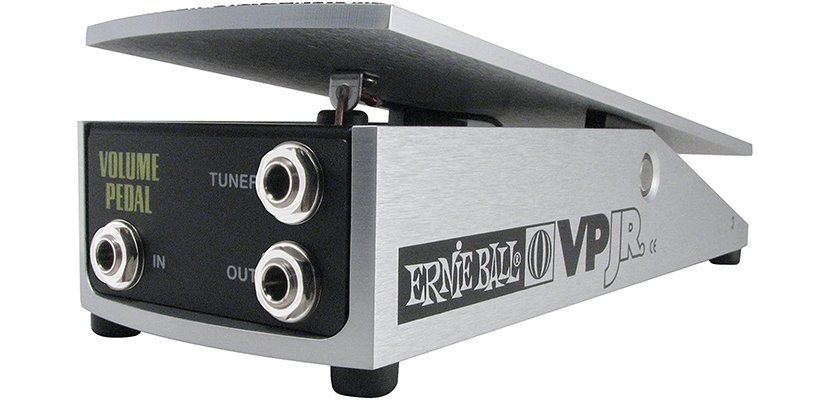
Looking for a professional performance pedal or one that will suit your rehearsal pedalboard without breaking the bank? The VP Jr. has solid built, tuner output, and lets choose the taper style. That’s why it’s often listed as the best guitar volume pedal on the dedicated charts. Still, its open design often leads to the contamination of the pot and ensuing troubles like uneven operation, squeaky sounds, and even the internal damage.
The pedal is designed to work with a passive guitar or another instrument and has the resistance of 250K Ohms. It passes the signal through almost neutral, without noticeable warmth characteristic for low-resistant pedals. The foot area is broad, allowing for a great deal of control over the pedal and its wide volume range. The signal is well distinct in the nearly bottom (heel down) position of the pedal.
Notwithstanding the “Jr.” tag, this Ernie Ball volume pedal is rather long (10 inches) and wide (3.5 inches). It has a comfortable height (2 ⅜ inches) and sits on four solid non-sliding feet. All the connections are located on the front of the device. Inside, there’s the stainless steel pivot shaft, which is fitted precisely and fixed with the nylon spacers. The pedal travel is transmitted through the thick Kevlar cable, and the durable stainless steel springs support the whole construction.
The tuner port enables performing the tuning at any volume, even in complete silence. The taper switch shifts between the classic volume swell and the vibrato-like swell. Considering the low-to-middle price for this device, it could well become the best volume pedal for both beginners and seasoned guitarists.
Pros
- The grainy foot area is water-, oil-, and other liquid resistant and provides a good grip.
- The wiring harness lets get inside without much effort for cleaning or replacing the pot with no soldering.
- Silent operation, no static to the sound signal.
Cons
- The taper switch isn’t within a quick reach (it’s on the inside of the foot grip area).
- The active tuner channel might produce noise to the signal.
Video Ernie Ball VP Jr. P06180
Ernie Ball P06165
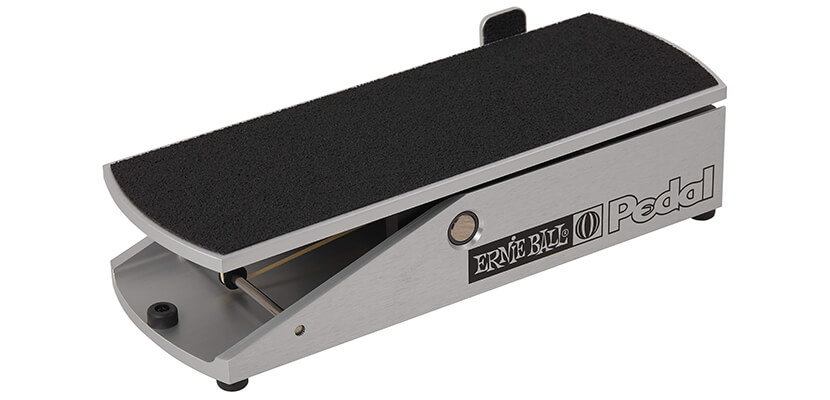
Implementing the panning capability and the mono / stereo mode, this Ernie Ball pedal is definitely worth your attention. It has a high resistance rate, solid build, and well-accessible controls. It houses two potentiometers secured by the rugged design and ensuring even operation. Still, as other gear by Ernie Ball, it’s quite big and heavy. The length makes 11 inches and would take yet more space on your pedalboard due to the cables connected. The pedal is also wide (4 inches) but not too tall (just 2 ¾ inches). It weighs 4.18lbs and is by no means a portable type. Still, this large weight fixes the pedal still even at the rave rock playing.
The design of this stereo volume pedal doesn’t differ much from other EB volume control gear. It features a strong metallic body, a black grainy top side, a black front panel, and four strong cylindric feet. The switch for changing between the panning and stereo mode is located at the toe zone near the top platform and is quite big. Still, it doesn’t require a lot of effort to shift between the modes.
In the mono mode, the pedal should be used via the “A” input and output. Hooked up to the stereo equipment with the TRS plugs, it works through the “B” input and output. It provides the gradual volume / effect increase, while closer to the top volume, it might seem a bit abrupt. With a resistance of 500K Ohms, this passive volume pedal is suitable for both high- and low-impedance instruments and gadgets.
Pros
- Can be hooked up to the expression pedals and provide “panning” between them.
- Intuitive to use, with smooth transitions and a clear sweet spot.
- The toe switch has a good response and works noiselessly.
Cons
- Cuts some gain in the central position during panning.
- High price.
Video Ernie Ball P06165
Yamaha FC7
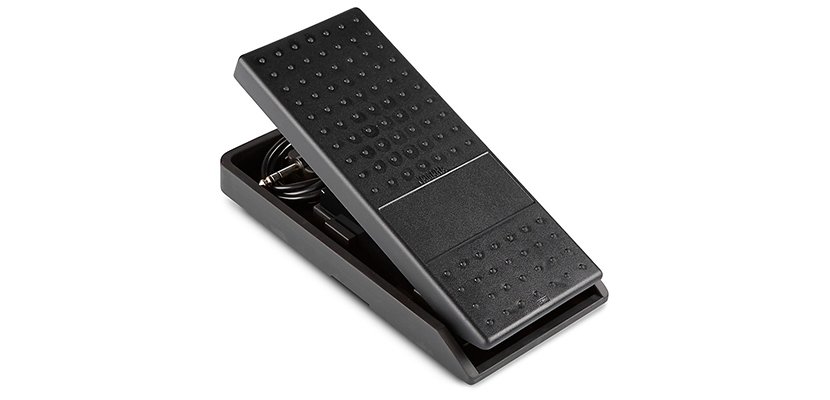
This keyboard volume control pedal combines a strong construction with flexibility and simplicity of use, and it is often cited as one of the best volume pedals. While the device cannot connect directly to a guitar, it can be plugged into an expression pedal or another effect gear through the Controller input — and be used as the volume / effect pedal in the chain.
The connection to the keyboard or another gear is performed via the 5ft cable with the phone plug (¼-inch jack). The cable can be stored within the device. The pedal is quite big (2.86lbs) and wide requiring considerable space on the pedalboard. It’s 9.84-inch long and 4.56-inch wide, while the height is less than in many guitar-oriented models (2.28 inches). This makes the pedal comfortable to press and regulate in the sitting position, but it can feel a bit shallow when standing up. The connection plate is made of metal ensuring the durability even at the hard usage.
The resistance of this model makes 50K Ohms +/-30%. It features the logarithmic taper with the smooth transitions and the next-to-zero sound color. When used after the expression pedals, it provides the same smooth response, but the sweet spot is usually slightly shifted. The unit is equipped with the “fortissimo function”, which brings a quick boost in volume or another effect.
Pros
- Regulated angle mechanism lets adjust the pedal for the individual user’s taste.
- The Dotted contact area with the division for the lower and upper part provides good grip and control over the pedal.
- The non-slip bottom plate secures the pedal and prevents it from sliding even on a hardwood floor.
Cons
- Adjusting the pedal angle requires using the screwdriver and isn’t handy during the gigs.
- The non-standard taper curve brings poor compatibility with non-Yamaha instruments.
Video Yamaha FC7
BOSS FV-500H
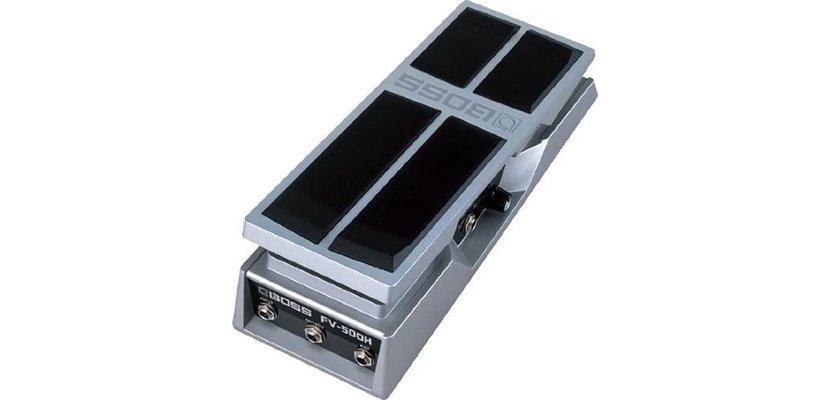
The first thing to say about the BOSS FV 500H is its tank-like build. It’s a long (14.25 inches), wide (5 inches), and tall (3.5 inches) pedal that weighs 3.52lbs, and it feels solid. It’s made of die-cast aluminum, and all the parts are assembled precisely. To ensure seamless functioning, the mechanism has been fine-tuned to be silent while in use. This sturdiness of build makes this pedal a good fit for the rehearsal room as well as for gig shows.
The impedance of the pedal is high, rated at 250K Ohms. It works well with the mono instruments like an electric guitar, violin, or synthesizer. The pedal can be placed the first in the chain or after the effect pedal. It can be connected to the FX controller via the AUX port and serve as the expression pedal. This port can also be connected to a tuner (the connection is constantly active).
The movement of the pedal is smooth and highly responsive by default. It provides a pinpoint control over the volume or effect swell, with the mostly gradual increase and distinct transitions. The torque of the pedal can be regulated via the side screw.
This BOSS volume pedal provides the additional comfort option. On the side, there’s also the regulator setting the minimum volume level. The regulation is precise and preserves the smoothness of response throughout the pedal travel.
Pros
- The movable portion of the pot is composed of metal and is resistant to wear.
- Preserves the fullness and transparency of the sound, no tone loss.
- Rubber grip mats on the top plate ensure the no-skip contact between the foot and the pedal.
Cons
- The logarithmic taper provides a small cliff in the volume raise / decrease.
- Doesn’t fit easily with the angled connectors.
Jim Dunlop DVP4
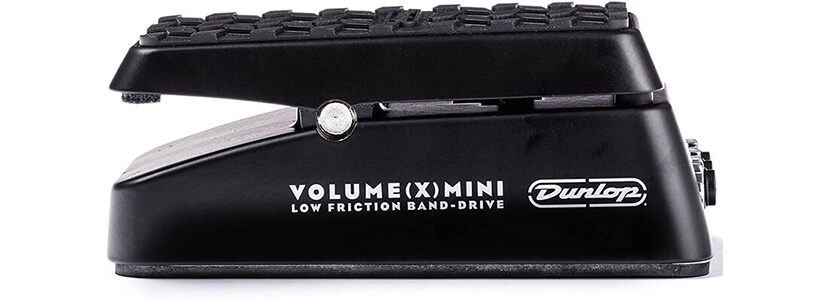
Versatility and solid build of this Dunlop volume pedal make it a primary choice on many pedal charts. Another significant aspect is that this device is portable and travel-friendly due to its small size and low weight.
The DVP4 is almost twice as small as the standard volume control pedal being just 6-inch long, 2.9-inch wide, and 2.5-inch tall. It will fit the smallest pedalboard and can be placed in the different positions in the chain (the first, middle, the last). It’s extremely lightweight weighing just 1.28lbs, which works great for gigs and travels. The rocker tension can be regulated via the side screw, so the pedal resistance can be set to the stiffer or milder operation.
This pedal consists of two main pots (for 10K Ohms and 250K Ohms) and works both for volume and effects control. It has three connections including the input, output, and AUX port for hooking up an expression pedal or a tuner. The switch located under the foot area (inside the pedal) lets choose between the “Tuner” or “Exp” modes. The 10K Ohms pot is responsible for effects control and provides the even linear taper with the well-distinct sweet spot. The 250K Ohms pot regulates the volume response. The increase is smooth and gradual.
Another interesting feature of the Dunlop mini volume pedal is the ability to change the polarity of the pedal action. This means that you can have the upper-level parameter at the heel down position, and the lowest — at the toe down one.
Pros
- 50K Ohms TRIMPOT sets the minimum level function for the expression pedal control.
- The mechanism is the band-drive with low friction and silent operation.
- Original “tiled” design of the foot contact area.
Cons
- Only the Expression mode allows you to change the polarity of the pedal action.
- The upper rocker part feels a bit wobbly.
Video Jim Dunlop DVP4
Sonicake CNSK001FR – active volume pedal
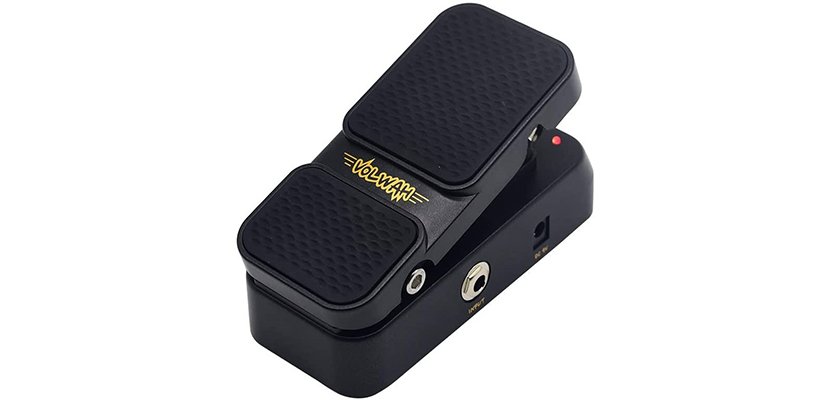
This bass volume pedal doubles as a volume controller and a traditional wah effect pedal, making it a two-in-one option. It’s active and requires the power supply (connected via the standard 9V DC port). Besides, it’s quite compact and lightweight; so, it’s worth entering your list of additions to your guitar or bass pedalboard.
As a volume regulation pedal, this device brings no tone loss thanks to the active design. The sound flows unchanged and full, while the volume increases evenly and gradually. The pedal travel isn’t too lengthy, but the mechanism is very sensitive, making it simple to locate your sound’s sweet spot. The swells are gradual and have a slightly accentuated upper level.
The “wah” portion of the pedal emits the classic Crybaby sound. The wah effect is produced with dynamics and is also responsive to the pedal motion. The switching between the wah and volume modes is performed through the footswitch inside (under the top plate). The implemented LED light signals the mode chosen and the status of the pedal’s operation.
Though being multi-functional, this active volume pedal doesn’t take much place on a pedalboard. It’s just 5.84-inches long (equal to the width of some full-size volume controllers), 2.56-inch wide, and 2.4-inch tall. Because the connections are on both sides of the pedal, it can’t be crammed between the other controllers on the board.
Pros
- Made of thick ABS plastic with the metal switch and connection ports and, feels solid under the foot, while lightweight (9oz).
- Large rubber mats with tapered surface ensure a good grip.
- Memorizes the last mode used before the power supply disconnection.
Cons
- No power adapter supplied.
- The LED light isn’t well visible to the player.
Video Sonicake CNSK001FR1
Donner EC1008
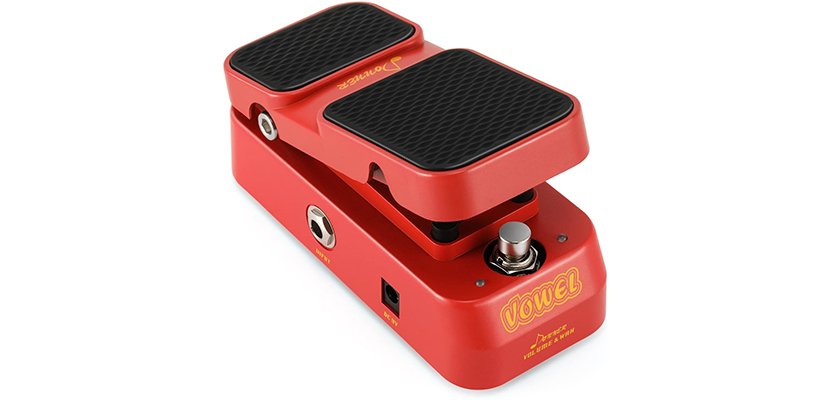
Do you need a small volume pedal with the active circuit and additional wah function? If you believe it should be big and costly, take a look at the Donner EC1008 model. Its lightweight (8.8oz) plastic construction and the small form factor are compensated with the powered circuit; so, the device doesn’t add noise to the signal ensuring the transparent passthrough. It doesn’t depend on the impedance, either, and can be used with multiple instruments and controllers.
The pedal is short (5.84 inches) and narrow (2.65 inches), with side connectors (an input and power supply port on the left, and the output on the right). The height of the device makes 2.4 inches. The connectors are metal and quite sturdy. The power port is a standard 9V DC one, but make sure to have the fitting adapter, as the latter isn’t supplied with this mini volume pedal.
Switching between the “wah” and volume modes is performed with the metal footswitch. The volume increase isn’t linear and provides a fast increase at the slightly-over-the-middle position of the pedal. The active circuit eliminates static noise and allows you to utilize cables of various lengths without compromising the sound quality. As the effect controller, this wah volume pedal produces the sound, which is very close to the vintage one.
Pros
- The fully analog circuit preserves the signal intact during the passthrough.
- Two-color LED light signalizes the current mode of the pedal (wah or volume).
- Solid non-sliding feet keep the pedal in place despite being a lightweight.
Cons
- The short throw of the pedal cuts the distance from minimum to maximum volume / effect and isn’t handy for seated play.
- No true bypass option.
Video Donner EC1008
Lehle Mono – best volume pedal for swells
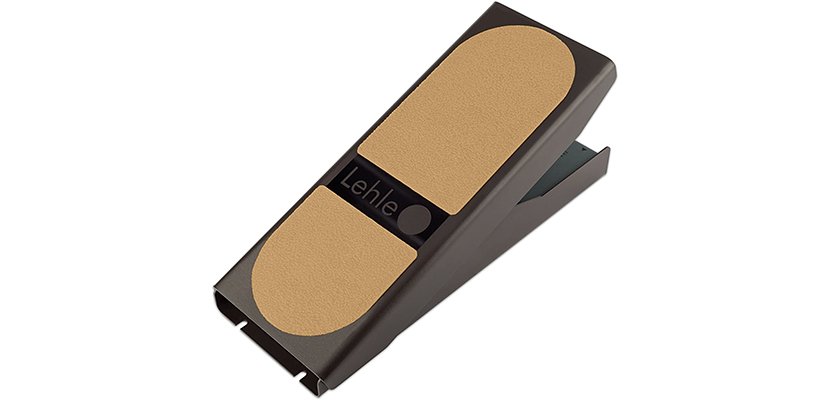
Built on the magnet and the voltage control unit rather than on the standard potentiometer, the Lehle volume pedal provides multiple benefits. The most obvious is the reduced friction and completely silent operation together with the wear-proof design. The magnet and the top plate, which is fitted with polymer low-friction bearings, are the moving components.
The length of the pedal makes 10.24 inches, width — 3.94 inches, the height equals 2.6 inches. It weights 3.57 pounds and may be fixed to the base or pedalboard with the included fasteners.
The pedal is active requiring the 8 – 15V DC power supply. It has the gain control knob adding the boost decibels to the sound (up to +10 dB). The dynamic range makes 110 dB. Thanks to the high input impedance (up to 2M Ohms) and the active circuit, the pedal can be used with the majority of instruments and other acoustic gear. The linear volume increase is gradual and smooth. The wide range of volume and the sensitive response make this unit the best volume pedal for swells. If you don’t mind the price, though.
Pros
- Supports the stable impedance of input and output ensuring the balanced and transparent sound output.
- Recessed gain control knob prevents inadvertent dialing.
- The buffered tuner output lets connect the tuner without cutting or distorting the primary signal.
Cons
- No minimum volume setting.
- Poor portability due to heavy weight.
Video Lehle Mono
Buyer’s Guide
The Variety of Volume Pedals and What’s the Difference Between Them?
The volume adjustment pedals provide much more control over the guitar volume than the guitar’s knob or the amplifier controls. However, the pedals vary by the type of power accepted (and the need for a power source at all), the presence or absence of a buffer, type of mechanism implemented for the pedal activation, acceptance of the mono or stereo sound signal. When the volume pedal is utilized in a chain of devices and may influence the output of other gear on the pedalboard, these differences become even more significant. Let’s briefly describe these pedal types.
Active or Passive
The active pedals increase and decrease the volume via a separate circuit requiring the external power source. This can be achieved through the 9V DC plug inserted into an outlet or the built-in or replaceable batteries. These models are usually buffered and provide more volume range and better control over the gain and the taper than the passive analogs. They can be put in the beginning, end, or in the middle of the gear chain without losing their output or affecting other pedals and effects. Due to the boosted output, they’re free from the tone suck issue and don’t cut the high frequencies of the guitar.
The passive volume pedals draw the power from the guitar itself or the chain they’re connected to. They don’t need an external power source but can impact other devices in the chain or change their own performance depending on their place in the chain.
Electro-Optical
This type of volume control device is an alternative to the widely used mechanical pedals. The electro-optical pedal uses a sensor that transforms the pressure of the pedal into the electric signal attenuating or boosting the volume. Since there’s no string and no friction, such a volume pedal usually lasts longer than the mechanical analogs. They also have a different level of sensitivity, which isn’t easy to adjust, while some mechanical pedals have this option. The electro-optical models are more expensive.
Stereo Volume Pedals
The majority of the volume pedals on the market are mono models designed to be used for a single instrument. However, the stereo ones also become quite popular due to their versatility. They have two inputs and can connect two sources, whether of a single type (e.g. two guitars) or different ones (e.g. a bass and a guitar). This provides the volume control for two instruments at once and lets you keep attention on the playing rather than on the differently located knobs. The stereo pedal also works well with the stereo music instruments like a synthesizer producing the simultaneous boost or decrease of all signal chains.
These pedals also provide two outputs, which presents another opportunity. It can be hooked up to two amps and produce multiple options for the panning effect. This can make your guitar sound feel voluminous and psychedelic or overly dry or provide another effect.

Hi everyone! I’m Thomas Moody, also known as Guitarzan.
